Never miss another geomagnetic storm. Sign up for Space Weather Alerts and you'll receive a text message when magnetic storms erupt. Aurora tour guides and professional astronomers use this service. You can, too! | | |
GLANCING-BLOW CME: NOAA forecasters say that a CME might deliver a glancing blow to Earth's magnetic field on May 21st. It left the sun yesterday, propelled by an erupting filament of magnetism in the sun's southern hemisphere. The impact could produce minor G1-class geomagnetic storms. Solar flare alerts: SMS Text.
MYSTERIOUS "AURORA BLOBS" EXPLAINED: Europeans are still trying to wrap their minds around what happened after sunset on April 23, 2023. Everyone knew that a CME was coming; photographers were already outside waiting for auroras. But when the auroras appeared, they were very strange.
"I had never seen anything quite like it," says Heiko Ulbricht of Saxony, Germany. "The auroras began to tear themselves apart, pulsating as they formed individual blobs that floated high in the sky."
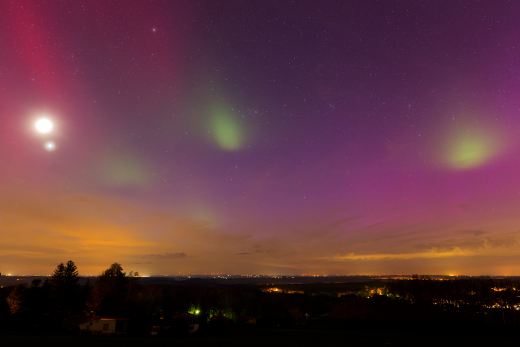
"It literally took my breath away," he says. "My pulse was still racing hours later!" The same blobs were sighted in France and Poland, and in Denmark they were caught flashing like a disco strobe light.
Ordinary auroras don't act like this.
Indeed, "these were not ordinary auroras," confirms space physicist Toshi Nishimura of Boston University. "They are called 'proton auroras,' and they come from Earth's ring current system."
Most people don't realize that Earth has rings. Unlike Saturn's rings, which are vast disks of glittering ice, Earth's rings are invisible to the naked eye. They are made of electricity--a donut-shaped circuit carrying millions of amps around our planet. The ring current skims the orbits of geosynchronous satellites and plays a huge role in determining the severity of geomagnetic storms.
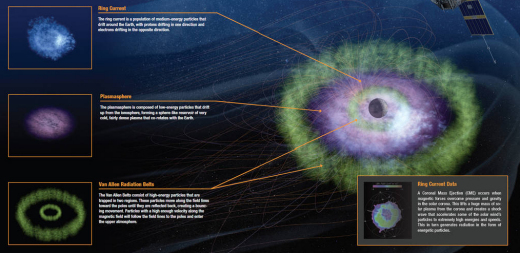
Sometimes during strong geomagnetic storms, protons rain down from the ring system, causing a secondary shower of electrons, which strike the atmosphere and make auroras. Earth-orbiting satellites have actually seen these protons on their way down. Ordinary auroras, on the other hand, are caused by particles from more distant parts of Earth's magnetosphere and have nothing to do with Earth's ring current.
Mystery solved? Not entirely. "We still don't know why proton auroras seem to tear themselves apart in such a dramatic way," says Nishimura. "This is a question for future research."
"It was very exciting to watch," says Ulbricht. "I definitely want to see them again."
Good, because they'll be back. Solar Cycle 25 ramping up to a potentially-strong Solar Maximum next year. Future storms will surely knock more protons loose from the ring current system.
Here's what to look for: (1) Proton auroras tend to appear around sunset. Why? Electric fields in Earth's magnetosphere push the protons toward the dusk not dawn side of our planet. (2) Proton auroras love to pulse--a sign of plasma wave activity in Earth's ring current. (3) Proton auroras are sometimes accompanied by deep red arcs of light (SARs), the glow of heat leaking from the ring current system. These red arcs were also seen on April 23rd.
Solar Max is coming. Let the proton rain begin!
Realtime Aurora Photo Gallery
Free: Spaceweather.com Newsletter
MR. SPOCK BEER COZY (BEER NOT INCLUDED): Father's Day is coming, and this is the gift every Trekkie Dad needs: the Mr. Spock beer cozy. The students of Earth to Sky Calculus launched it to the stratosphere onboard a cosmic ray research balloon:
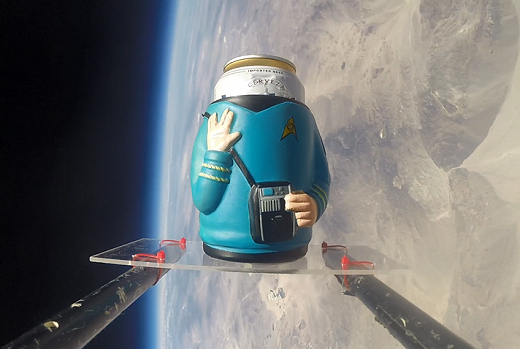
You can have it for $99.95. The students are selling beer cozies (beer not included) to support their cosmic ray ballooning program. They make great Father's Day and birthday gifts. Each one comes with greeting card showing the cozy in flight, and telling the story of its trip to the stratosphere and back again.
Far Out Gifts: Earth to Sky Store
All sales support hands-on STEM education
Realtime Space Weather Photo Gallery
Free: Spaceweather.com Newsletter
Every night, a network of
NASA all-sky cameras scans the skies above the United States for meteoritic fireballs. Automated software maintained by NASA's Meteoroid Environment Office calculates their orbits, velocity, penetration depth in Earth's atmosphere and many other characteristics. Daily results are presented here on Spaceweather.com.
On May 18, 2023, the network reported 3 fireballs.
(3 sporadics)
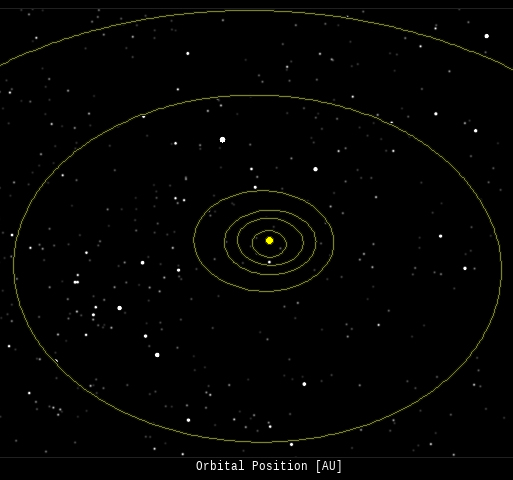
In this diagram of the inner solar system, all of the fireball orbits intersect at a single point--Earth. The orbits are color-coded by velocity, from slow (red) to fast (blue). [Larger image] [movies]
Potentially Hazardous Asteroids (
PHAs) are space rocks larger than approximately 100m that can come closer to Earth than 0.05 AU. None of the known PHAs is on a collision course with our planet, although astronomers are finding
new ones all the time.
On May 18, 2023 there were 2316 potentially hazardous asteroids.
 |
Recent & Upcoming Earth-asteroid encounters: | Asteroid | Date(UT) | Miss Distance | Velocity (km/s) | Diameter (m) |
| 2023 JD1 | 2023-May-13 | 7.8 LD | 6.7 | 20 |
| 2023 JG | 2023-May-13 | 18.6 LD | 15.3 | 51 |
| 2023 JN2 | 2023-May-13 | 1.4 LD | 20.2 | 14 |
| 2023 JR1 | 2023-May-14 | 1 LD | 20.2 | 13 |
| 2023 JP | 2023-May-14 | 8.4 LD | 7.8 | 27 |
| 2023 JL1 | 2023-May-15 | 6.5 LD | 7.3 | 12 |
| 2023 JO1 | 2023-May-16 | 7.8 LD | 8.3 | 15 |
| 2023 JD2 | 2023-May-16 | 14.7 LD | 13 | 64 |
| 2023 JS1 | 2023-May-17 | 5.7 LD | 8 | 12 |
| 2023 JC3 | 2023-May-17 | 12.8 LD | 13.4 | 20 |
| 2023 JT2 | 2023-May-17 | 6.9 LD | 4.5 | 10 |
| 2023 JT4 | 2023-May-18 | 5.1 LD | 3.2 | 7 |
| 2023 JW3 | 2023-May-18 | 8.4 LD | 8.1 | 27 |
| 2011 KY15 | 2023-May-18 | 19.9 LD | 14.3 | 54 |
| 2023 JS4 | 2023-May-18 | 16.2 LD | 13.8 | 38 |
| 2023 JL2 | 2023-May-20 | 15.6 LD | 9.4 | 42 |
| 2023 HG11 | 2023-May-20 | 11.8 LD | 0.4 | 7 |
| 2023 JK | 2023-May-21 | 4.3 LD | 9.3 | 38 |
| 2023 JD4 | 2023-May-21 | 8.1 LD | 10.3 | 37 |
| 2021 JK7 | 2023-May-22 | 16.7 LD | 22.9 | 48 |
| 2023 JK3 | 2023-May-22 | 1.6 LD | 4.9 | 28 |
| 2023 GY2 | 2023-May-22 | 18.1 LD | 11.3 | 96 |
| 2023 JZ1 | 2023-May-22 | 10.7 LD | 13 | 38 |
| 2019 UJ3 | 2023-May-23 | 15.5 LD | 9.8 | 21 |
| 2023 JK1 | 2023-May-23 | 17.1 LD | 8.7 | 37 |
| 2023 JC4 | 2023-May-24 | 17.7 LD | 4.2 | 30 |
| 2023 CL3 | 2023-May-24 | 18.9 LD | 7.3 | 117 |
| 2023 JP2 | 2023-May-25 | 11.5 LD | 20.5 | 90 |
| 2023 JR4 | 2023-May-25 | 4.1 LD | 9.4 | 14 |
| 2023 JE2 | 2023-May-27 | 19.7 LD | 11.4 | 36 |
| 2023 JZ3 | 2023-May-28 | 14.2 LD | 4.1 | 25 |
| 2021 KO2 | 2023-May-29 | 15.8 LD | 13.9 | 9 |
| 2023 JZ4 | 2023-May-29 | 6 LD | 16.1 | 33 |
| 2012 KP24 | 2023-May-31 | 10.3 LD | 12.4 | 19 |
| 2023 JM1 | 2023-Jun-01 | 10.1 LD | 5.2 | 21 |
| 2023 JE5 | 2023-Jun-04 | 17.6 LD | 8 | 35 |
| 2023 JR2 | 2023-Jun-04 | 17 LD | 7.6 | 44 |
| 2018 KR | 2023-Jun-07 | 6.5 LD | 4.9 | 19 |
| 2017 UJ2 | 2023-Jun-07 | 5.3 LD | 5.6 | 2 |
| 2023 JB3 | 2023-Jun-09 | 14.1 LD | 7 | 47 |
| 488453 | 2023-Jun-12 | 8.3 LD | 21.5 | 495 |
| 2022 WN4 | 2023-Jun-13 | 10.8 LD | 15.1 | 158 |
| 2020 DB5 | 2023-Jun-15 | 11.3 LD | 9.5 | 506 |
| 2023 HL | 2023-Jun-17 | 13.5 LD | 1 | 15 |
| 2016 LK49 | 2023-Jun-19 | 17.4 LD | 19.4 | 22 |
| 2018 LN2 | 2023-Jun-20 | 19 LD | 9.9 | 84 |
| 2023 HF1 | 2023-Jun-21 | 12.5 LD | 4.4 | 59 |
| 467336 | 2023-Jun-24 | 17.4 LD | 7.1 | 269 |
| 2008 LG2 | 2023-Jun-24 | 10.5 LD | 5.6 | 32 |
| 2022 MM1 | 2023-Jun-29 | 9.5 LD | 9.8 | 41 |
| 2020 NC | 2023-Jul-02 | 13.9 LD | 7.7 | 123 |
| 2023 HO6 | 2023-Jul-05 | 5.3 LD | 7.8 | 234 |
| 2019 LH5 | 2023-Jul-07 | 14.9 LD | 21.6 | 281 |
| 2018 NW | 2023-Jul-10 | 18 LD | 21.8 | 10 |
| 2018 UY | 2023-Jul-12 | 7.4 LD | 16.4 | 243 |
Notes: LD means "Lunar Distance." 1 LD = 384,401 km, the distance between Earth and the Moon. 1 LD also equals 0.00256 AU. | | Cosmic Rays in the Atmosphere |
SPACE WEATHER BALLOON DATA: Almost once a week, Spaceweather.com and the students of Earth to Sky Calculus fly space weather balloons to the stratosphere over California. These balloons are equipped with sensors that detect secondary cosmic rays, a form of radiation from space that can penetrate all the way down to Earth's surface. Our monitoring program has been underway without interruption for 7 years, resulting in a unique dataset of in situ atmospheric measurements.
Latest results (July 2022): Atmospheric radiation is decreasing in 2022. Our latest measurements in July 2022 registered a 6-year low:
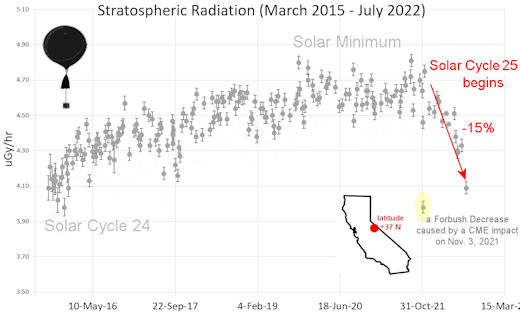
What's going on? Ironically, the radiation drop is caused by increasing solar activity. Solar Cycle 25 has roared to life faster than forecasters expected. The sun's strengthening and increasingly tangled magnetic field repels cosmic rays from deep space. In addition, solar coronal mass ejections (CMEs) sweep aside cosmic rays, causing sharp reductions called "Forbush Decreases." The two effects blend together to bring daily radiation levels down.
.Who cares? Cosmic rays are a surprisingly "down to Earth" form of space weather. They can alter the chemistry of the atmosphere, trigger lightning, and penetrate commercial airplanes. According to a study from the Harvard T.H. Chan school of public health, crews of aircraft have higher rates of cancer than the general population. The researchers listed cosmic rays, irregular sleep habits, and chemical contaminants as leading risk factors. A number of controversial studies (#1, #2, #3, #4) go even further, linking cosmic rays with cardiac arrhythmias and sudden cardiac death.
Technical notes: The radiation sensors onboard our helium balloons detect X-rays and gamma-rays in the energy range 10 keV to 20 MeV. These energies span the range of medical X-ray machines and airport security scanners.
Data points in the graph labeled "Stratospheric Radiation" correspond to the peak of the Regener-Pfotzer maximum, which lies about 67,000 feet above central California. When cosmic rays crash into Earth's atmosphere, they produce a spray of secondary particles that is most intense at the entrance to the stratosphere. Physicists Eric Regener and Georg Pfotzer discovered the maximum using balloons in the 1930s and it is what we are measuring today.
| | The official U.S. government space weather bureau |
| | The first place to look for information about sundogs, pillars, rainbows and related phenomena. |
| | Researchers call it a "Hubble for the sun." SDO is the most advanced solar observatory ever. |
| | 3D views of the sun from NASA's Solar and Terrestrial Relations Observatory |
| | Realtime and archival images of the Sun from SOHO. |
| | information about sunspots based on the latest NOAA/USAF Active Region Summary |
| | current counts of failed and deployed Starlink satellites from Jonathan's Space Page |
| | Authoritative predictions of space junk and satellite re-entries |
| | from the NOAA Space Environment Center |
| | fun to read, but should be taken with a grain of salt! Forecasts looking ahead more than a few days are often wrong. |
| | from the NOAA Space Environment Center |
| | the underlying science of space weather |
 | Getting YouTube comments is essential if you want to beat the algorithm! That’s why you need to buy YouTube comments from RealSocialz.com because they offer real USA comments you can customize. |
 | BestCSGOGambling is the best site for everything related to CSGO gambling on the web |
 | Looking for sports betting companies not registered on GamStop? CasinoGap has presented a list of sites not on GamStop available for UK players. Check and bet online! Would you like to bet at sites not using GamStop? Look at a list of NonStopCasino sites for online betting that aren't on GamStop. Top-rated bookmakers ever! |
| | These links help Spaceweather.com stay online. Thank you to our supporters! |
| | | | | | |

